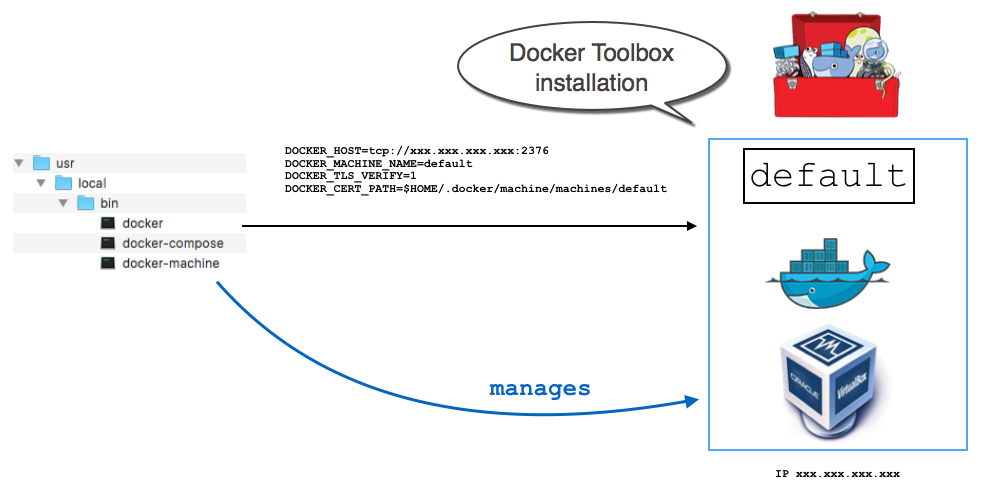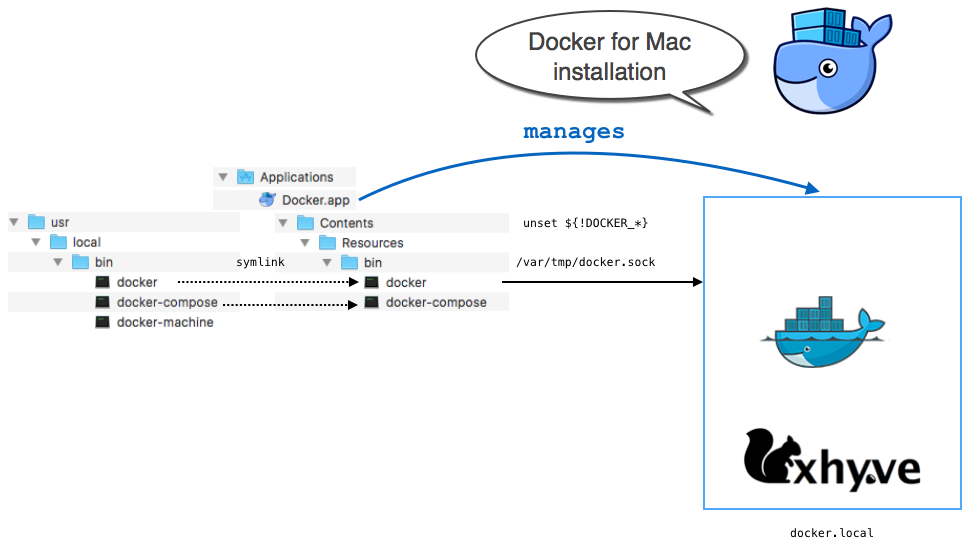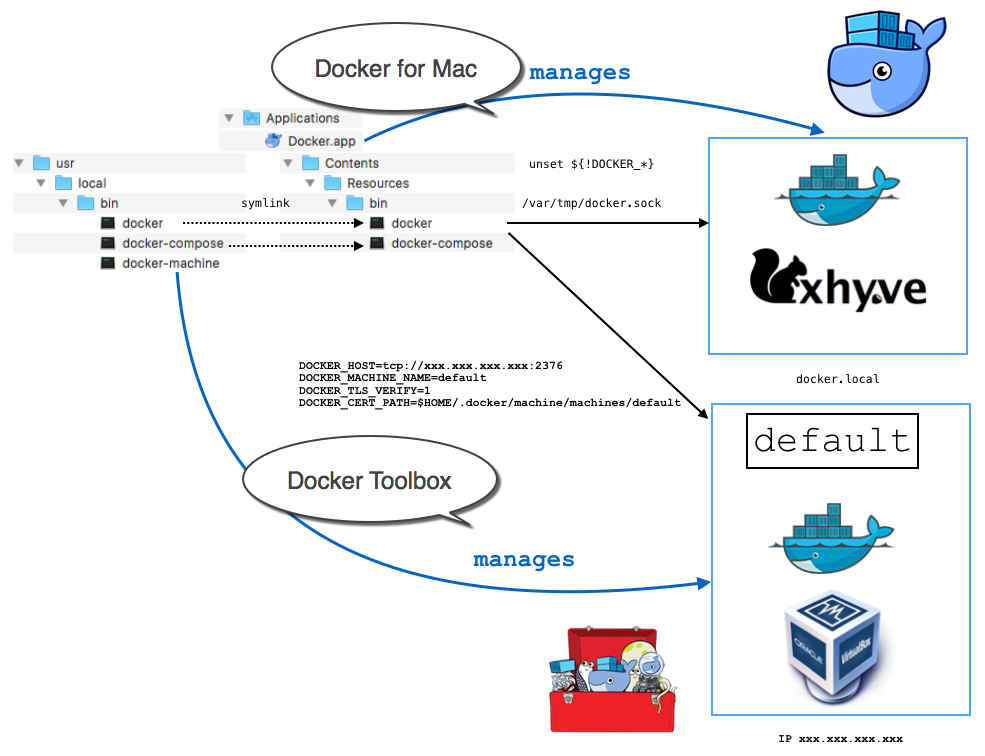Docker for Mac vs. Docker Toolbox
Estimated reading time: 6 minutesIf you already have an installation of Docker Toolbox, please read these topics first to learn how Docker for Mac and Docker Toolbox differ, and how they can coexist.
The Docker Toolbox environment
Docker Toolbox installs docker, docker-compose and docker-machine in /usr/local/bin on your Mac. It also installs VirtualBox. At installation time, Toolbox uses docker-machine to provision a VirtualBox VM called default, running the boot2docker Linux distribution, with Docker Engine with certificates located on your Mac at $HOME/.docker/machine/machines/default.
Before you use docker or docker-compose on your Mac, you typically use the command eval $(docker-machine env default) to set environment variables so that docker or docker-compose know how to talk to Docker Engine running on VirtualBox.
This setup is shown in the following diagram.

The Docker for Mac environment
Docker for Mac is a Mac native application, that you install in /Applications. At installation time, it creates symlinks in /usr/local/bin for docker and docker-compose, to the version of the commands inside the Mac application bundle, in /Applications/Docker.app/Contents/Resources/bin.
Here are some key points to know about Docker for Mac before you get started:
-
Docker for Mac does not use VirtualBox, but rather HyperKit, a lightweight macOS virtualization solution built on top of Hypervisor.framework in macOS 10.10 Yosemite and higher.
-
Installing Docker for Mac does not affect machines you created with Docker Machine. The install offers to copy containers and images from your local
defaultmachine (if one exists) to the new Docker for Mac HyperKit VM. If chosen, content fromdefaultis copied to the new Docker for Mac HyperKit VM, and your originaldefaultmachine is kept as is. -
The Docker for Mac application does not use
docker-machineto provision that VM; but rather creates and manages it directly. -
At installation time, Docker for Mac provisions an HyperKit VM based on Alpine Linux, running Docker Engine. It exposes the docker API on a socket in
/var/run/docker.sock. Since this is the default location wheredockerwill look if no environment variables are set, you can start usingdockeranddocker-composewithout setting any environment variables.
This setup is shown in the following diagram.

With Docker for Mac, you get only one VM, and you don’t manage it. It is managed by the Docker for Mac application, which includes autoupdate to update the client and server versions of Docker.
If you need several VMs and want to manage the version of the Docker client or server you are using, you can continue to use docker-machine, on the same machine, as described in Docker Toolbox and Docker for Mac coexistence.
Setting up to run Docker for Mac
-
Check whether Toolbox DOCKER environment variables are set:
$ env | grep DOCKER DOCKER_HOST=tcp://192.168.99.100:2376 DOCKER_MACHINE_NAME=default DOCKER_TLS_VERIFY=1 DOCKER_CERT_PATH=/Users/victoriabialas/.docker/machine/machines/defaultIf this command returns no output, you are ready to use Docker for Mac.
If it returns output (as shown in the example), you need to unset the
DOCKERenvironment variables to make the client talk to the Docker for Mac Engine (next step). -
Run the
unsetcommand on the followingDOCKERenvironment variables to unset them in the current shell.unset DOCKER_TLS_VERIFY unset DOCKER_CERT_PATH unset DOCKER_MACHINE_NAME unset DOCKER_HOST
Now, this command should return no output.
$ env | grep DOCKER
If you are using a Bash shell, you can use unset ${!DOCKER_*} to unset all DOCKER environment variables at once. (This will not work in other shells such as zsh; you will need to unset each variable individually.)
Note: If you have a shell script as part of your profile that sets these
DOCKERenvironment variables automatically each time you open a command window, then you will need to unset these each time you want to use Docker for Mac.
Warning: If you install Docker for Mac on a machine where Docker Toolbox is installed, it will replace the
dockeranddocker-composecommand lines in/usr/local/binwith symlinks to its own versions.
Docker Toolbox and Docker for Mac coexistence
You can use Docker for Mac and Docker Toolbox together on the same machine. When you want to use Docker for Mac, make sure all DOCKER environment variables are unset. You can do this in bash with unset ${!DOCKER_*}. When you want to use one of the VirtualBox VMs you have set with docker-machine, just run a eval $(docker-machine env default) (or the name of the machine you want to target). This will switch the current command shell to talk to the specified Toolbox machine.
This setup is represented in the following diagram.

Using different versions of Docker tools
The coexistence setup works as is as long as your VirtualBox VMs provisioned with docker-machine run the same version of Docker Engine as Docker for Mac. If you need to use VMs running older versions of Docker Engine, you can use a tool like Docker Version Manager to manage several versions of docker client.
Checking component versions
Ideally, the Docker CLI client and Docker Engine should be the same version. Mismatches between client and server, and among host machines you might have created with Docker Machine can cause problems (client can’t talk to the server or host machines).
If you already have Docker Toolbox installed, and then install Docker for Mac, you might get a newer version of the Docker client. Run docker version in a command shell to see client and server versions. In this example, the client installed with Docker for Mac is Version: 1.11.1 and the server (which was installed earlier with Toolbox) is Version: 1.11.0.
$ docker version
Client:
Version: 1.11.1
...
Server:
Version: 1.11.0
...
Also, if you created machines with Docker Machine (installed with Toolbox) then upgraded or installed Docker for Mac, you might have machines running different versions of Engine. Run docker-machine ls to view version information for the machines you created. In this example, the DOCKER column shows that each machine is running a different version of server.
$ docker-machine ls
NAME ACTIVE DRIVER STATE URL SWARM DOCKER ERRORS
aws-sandbox - amazonec2 Running tcp://52.90.113.128:2376 v1.10.0
default * virtualbox Running tcp://192.168.99.100:2376 v1.10.1
docker-sandbox - digitalocean Running tcp://104.131.43.236:2376 v1.10.0
You might also run into a similar situation with Docker Universal Control Plan (UCP).
There are a few ways to address this problem and keep using your older machines. One solution is to use a version manager like DVM.
How do I uninstall Docker Toolbox?
You might decide that you do not need Toolbox now that you have Docker for Mac, and want to uninstall it. For details on how to perform a clean uninstall of Toolbox on the Mac, see How to uninstall Toolbox in the Toolbox Mac topics.
 Feedback? Suggestions? Can't find something in the docs?
Feedback? Suggestions? Can't find something in the docs?Edit this page ● Request docs changes ● Get support
Rate this page:
